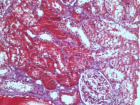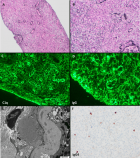Abstract
Research Article
Evaluation of Biostimulants Based on Recovered Protein Hydrolysates from Animal By-products as Plant Growth Enhancers
H Pérez-Aguilar*, M Lacruz-Asaro and F Arán-Ais
Published: 03 July, 2023 | Volume 7 - Issue 2 | Pages: 042-047
Free amino acids-based biostimulants are gaining momentum in Europe for sustainable agriculture. They stimulate plant growth, improve crop productivity, and reduce reliance on harmful fertilizers. Enzymatic hydrolysis is used to develop biostimulants from animal by-products, such as greaves and protein-rich wastewater from processed animal proteins. The effectiveness of enzymatic hydrolysis depends on selecting the appropriate conditioning stage for the by-products, yielding protein in the range of 86% to 97%. These protein hydrolysates, with optimal amino acid compositions, are evaluated as biostimulants. Promising results show growth improvements of 17% to 31% in Chinese cabbage and lettuce seeds. The optimal dilution concentration ranges from 0.05% to 0.3%, depending on the protein hydrolysate used. The findings highlight the potential of these biostimulants to enhance plant growth and productivity while reducing environmental impact by replacing chemical fertilizers. They offer sustainable alternatives for promoting environmentally friendly practices in agriculture.
Read Full Article HTML DOI: 10.29328/journal.jpsp.1001104 Cite this Article Read Full Article PDF
Keywords:
Amino acids; Enzymatic hydrolysis; Wastewater; Rendering; protein recovery
References
- European Commission. Integrated Pollution Prevention and Control. Reference Document on Best Available Techniques in the Slaughterhouses and Animal By-products Industries. 2005. https://eippcb.jrc.ec.europa.eu/sites/default/files/2020-01/sa_bref_0505.pdf
- Cheng D, Liu Y, Ngo HH, Guo W, Chang SW, Nguyen DD, Zhang S, Luo G, Bui XT. Sustainable enzymatic technologies in waste animal fat and protein management. J Environ Manage. 2021 Apr 15;284:112040. doi: 10.1016/j.jenvman.2021.112040. Epub 2021 Feb 9. PMID: 33571854.
- Chuck-Hernández C, Ozuna C. Chapter 5 - Protein Isolates From Meat Processing By-Products. In: Galanakis CM, editor. Proteins: Sustainable Source, Processing and Applications. 2019; 131–62. https://www.sciencedirect.com/science/article/pii/B9780128166956000052
- Lapeña D, Vuoristo KS, Kosa G, Horn SJ, Eijsink VGH. Comparative Assessment of Enzymatic Hydrolysis for Valorization of Different Protein-Rich Industrial Byproducts. J Agric Food Chem. 2018 Sep 19;66(37):9738-9749. doi: 10.1021/acs.jafc.8b02444. Epub 2018 Sep 11. PMID: 30142267.
- Morimura S, Nagata H, Uemura Y, Fahmi A, Shigematsu T, Kida K. Development of an effective process for utilization of collagen from livestock and fish waste. Process Biochemistry. 2002 Jul 1; 37(12):1403–12. https://www.sciencedirect.com/science/article/pii/S0032959202000249
- Ohba R, Deguchi T, Kishikawa M, Arsyad F, Morimura S, Kida K. Physiological Functions of Enzymatic Hydrolysates of Collagen or Keratin Contained in Livestock and Fish Waste. Food Science and Technology Research. 2003;9(1):91–3.
- Pagán J, Ibarz A, Falguera V, Benítez R. Enzymatic hydrolysis kinetics and nitrogen recovery in the protein hydrolysate production from pig bones. Journal of Food Engineering. 2013 Dec 1; 119(3):655–9. https://www.sciencedirect.com/science/article/pii/S0260877413003415
- Jayathilakan K, Sultana K, Radhakrishna K, Bawa AS. Utilization of byproducts and waste materials from meat, poultry and fish processing industries: a review. J Food Sci Technol. 2012 Jun; 49(3):278–93. https://www.ncbi.nlm.nih.gov/pmc/articles/PMC3614052/
- Naveed M, Nadeem F, Mehmood T, Bilal M, Anwar Z, Amjad F. Protease—A Versatile and Ecofriendly Biocatalyst with Multi-Industrial Applications: An Updated Review. Catal Lett. 2021; 151(2):307–23. https://link.springer.com/10.1007/s10562-020-03316-7
- Zhang Y, Olsen K, Grossi A, Otte J. Effect of pretreatment on enzymatic hydrolysis of bovine collagen and formation of ACE-inhibitory peptides. Food Chem. 2013 Dec 1;141(3):2343-54. doi: 10.1016/j.foodchem.2013.05.058. Epub 2013 May 24. PMID: 23870967.
- Damgaard T, Lametsch R, Otte J. Antioxidant capacity of hydrolyzed animal by-products and relation to amino acid composition and peptide size distribution. J Food Sci Technol. 2015 Oct;52(10):6511-9. doi: 10.1007/s13197-015-1745-z. Epub 2015 Feb 5. PMID: 26396396; PMCID: PMC4573118.
- Gómez-Guillén MC, Giménez B, López-Caballero ME, Montero MP. Functional and bioactive properties of collagen and gelatin from alternative sources: A review. Food Hydrocoll. 2011; 25(8):1813-1827. DOI: 10.1016/j.foodhyd.2011.02.007.
- Gutterres M, daSilva IV. Leather retanning with hydrolyzed protein. Journal of the American Leather Chemists Association. 2010 Jun 1; 105(06):195–202. https://journals.uc.edu/index.php/JALCA/article/view/3267
- Langmaier F, Mokrejs P, Kolomaznik K, Mladek M. Biodegradable packing materials from hydrolysates of collagen waste proteins. Waste Manag. 2008;28(3):549-56. doi: 10.1016/j.wasman.2007.02.003. Epub 2007 Mar 21. PMID: 17376664.
- Akter N, Fatema K, Azad AK, Chakma S. Acid hydrolysis of untanned proteinous wastes from tannery industry in Bangladesh. J Sci Innov Res. 2020 Sep 30; 9(3):83–6. http://www.jsirjournal.com/Vol9_Issue3_01.pdf
- Morimura S, Nagata H, Uemura Y, Fahmi A, Shigematsu T, Kida K. Development of an effective process for utilization of collagen from livestock and fish waste. Process Biochemistry. 2002 Jul 1; 37(12):1403–12. https://www.sciencedirect.com/science/article/pii/S0032959202000249
- Sathish M, Madhan B, Raghava Rao J. Leather solid waste: An eco-benign raw material for leather chemical preparation - A circular economy example. Waste Manag. 2019 Mar 15;87:357-367. doi: 10.1016/j.wasman.2019.02.026. Epub 2019 Feb 15. PMID: 31109536.
- Ammasi R, Victor JS, Chellan R, Chellappa M. Amino Acid Enriched Proteinous Wastes: Recovery and Reuse in Leather Making. Waste Biomass Valor. 2020 Nov 1; 11(11):5793–807. https://doi.org/10.1007/s12649-019-00912-6
- Damrongsakkul S, Ratanathammapan K, Komolpis K, Tanthapanichakoon W. Enzymatic hydrolysis of rawhide using papain and neutrase. Journal of Industrial and Engineering Chemistry. 2008 Mar 1; 14(2):202–6. https://www.sciencedirect.com/science/article/pii/S1226086X07000299
- Hervas F, Celma P, Punti I, Manich A, Cot J, Marsal A, et al. The Enzyme Activity of Trypsen on Sheepskin Trimmings in a Two-Step Collagen Extraction Process. Journal of The American Leather Chemists Association. 2007; https://www.semanticscholar.org/paper/The-Enzyme-Activity-of-Trypsen-on-Sheepskin-in-a-Hervas-Celma/2e7430d448f9213dff47648d2cadf1f4281075d4
- Kanagaraj J, Senthilvelan T, Panda RC, Kavitha S. Eco-friendly waste management strategies for greener environment towards sustainable development in leather industry: a comprehensive review. Journal of Cleaner Production. 2015 Feb 15; 89:1–17. https://www.sciencedirect.com/science/article/pii/S0959652614011858
- Kumaraguru S, Sastry T, Rose C. Hydrolysis of Tannery Fleshings Using Pancreatic Enzymes: A Biotechnological Tool for Solid Waste Management. Journal of The American Leather Chemists Association. 1998; https://www.semanticscholar.org/paper/Hydrolysis-of-Tannery-Fleshings-Using-Pancreatic-A-Kumaraguru-Sastry/09a0dc35a756c8c2efdf77d6a6d9ddfc73309f89
- Masilamani D, Madhan B, Shanmugam G, Palanivel S, Narayan B. Extraction of collagen from raw trimming wastes of tannery: a waste to wealth approach. Journal of Cleaner Production. 2016 Feb 1; 113:338–44. https://www.sciencedirect.com/science/article/pii/S0959652615018053
- Puhazhselvan P, Pandi A, Sujiritha PB, Antony GS, Jaisankar SN, Ayyadurai N, et al. Recycling of tannery fleshing waste by a two step process for preparation of retanning agent. Process Safety and Environmental Protection. 2022 Jan 1; 157:59–67. https://www.sciencedirect.com/science/article/pii/S0957582021005991
- Selvaraj S, Jeevan V, Rao Jonnalagadda R, Nishad Fathima N. Conversion of tannery solid waste to sound absorbing nanofibrous materials: A road to sustainability. Journal of Cleaner Production. 2019 Mar 10; 213:375–83. https://www.sciencedirect.com/science/article/pii/S095965261833854X
- Sundar JV, Gnanamani A, Muralidharan C, Chandrababu NK, Mandal AB. Recovery and utilization of proteinous wastes of leather making: a review. Rev Environ Sci Biotechnol. 2011 Jun 1; 10(2):151–63. https://doi.org/10.1007/s11157-010-9223-6
- Álvarez C, Lélu P, Lynch SA, Tiwari BK. Optimised protein recovery from mackerel whole fish by using sequential acid/alkaline isoelectric solubilization precipitation (ISP) extraction assisted by ultrasound. LWT. 2017; 88:210–216. https://doi.org/10.1016/j.lwt.2017.09.045
- Ansari AJ, Hai FI, Price WE, Drewes JE, Nghiem LD. Forward osmosis as a platform for resource recovery from municipal wastewater - A critical assessment of the literature. Journal of Membrane Science. 2017; 529:195–206. https://doi.org/10.1016/j.memsci.2017.01.054
- Khiari Z, Pietrasik Z, Gaudette NJ, Betti M. Poultry protein isolate prepared using an acid solubilization/precipitation extraction influences the microstructure, the functionality and the consumer acceptability of a processed meat product. Food Structure. 2014; 2:49–60. https://doi.org/10.1016/j.foostr.2014.08.002
- Lo YM, Cao D, Argin-Soysal S, Wang J, Hahm TS. Recovery of protein from poultry processing wastewater using membrane ultrafiltration. Bioresour Technol. 2005 Apr;96(6):687-98. doi: 10.1016/j.biortech.2004.06.026. PMID: 15588771.
- Matak KE, Tahergorabi R, Jaczynski J. A review: Protein isolates recovered by isoelectric solubilization/precipitation processing from muscle food by-products as a component of nutraceutical foods. Food Research International, Innovative food processing technologies: chemical, nutritional and microbiological aspects. 2017; 77:697–703. https://doi.org/10.1016/j.foodres.2015.05.048
- Melchiors MS, Piovesan M, Becegato VR, Becegato VA, Tambourgi EB, Paulino AT. Treatment of wastewater from the dairy industry using electroflocculation and solid whey recovery. Journal of Environmental Management. 2016; 182:574–580. https://doi.org/10.1016/j.jenvman.2016.08.022
- Galanakis CM. Food Waste Recovery: Processing Technologies, Industrial Techniques, and Applications. Academic Press. 2015 https://doi.org/10.1016/C2013-0-16046-1
- Ganju S, Gogate PR. A review on approaches for efficient recovery of whey proteins from dairy industry effluents. Journal of Food Engineering. 2017; 215:84–96. https://doi.org/10.1016/j.jfoodeng.2017.07.021
- Pérez-Aguilar H, Lacruz-Asaro M, Arán-Ais F. Towards a circular bioeconomy: High added value protein recovery and recycling from animal processing by-products. Sustainable Chemistry and Pharmacy. 2022; 28:100667. https://linkinghub.elsevier.com/retrieve/pii/S2352554122000717
- Colla G, Hoagland L, Ruzzi M, Cardarelli M, Bonini P, Canaguier R, Rouphael Y. Biostimulant Action of Protein Hydrolysates: Unraveling Their Effects on Plant Physiology and Microbiome. Front Plant Sci. 2017 Dec 22;8:2202. doi: 10.3389/fpls.2017.02202. PMID: 29312427; PMCID: PMC5744479.
- Pérez-Aguilar H, Lacruz-Asaro M, Ruzafa-Silvestre C, Arán-Ais F. Protein recovery from wastewater animal processing by-products of rendering plants for biostimulant applications in agriculture. Sustainable Chemistry and Pharmacy. 2023; 32:101009. https://linkinghub.elsevier.com/retrieve/pii/S2352554123000438
- Martín MHJ, Ángel MMM, Aarón SLJ, Israel BG. Protein Hydrolysates as Biostimulants of Plant Growth and Development. In: Ramawat N, Bhardwaj V, editors. Biostimulants: Exploring Sources and Applications. Singapore: Springer Nature Singapore. 2022;141–75. https://link.springer.com/10.1007/978-981-16-7080-0_6
- Pituello C, Ambrosini S, Varanini Z, Pandolfini T, Zamboni A, Povolo C, et al. Animal-Derived Hydrolyzed Protein and Its Biostimulant Effects. In: Ramawat N, Bhardwaj V, editors. Biostimulants: Exploring Sources and Applications. Singapore: Springer Nature Singapore; 2022. p. 107–40. https://link.springer.com/10.1007/978-981-16-7080-0_5
- Povolo C, Avolio R, Doria E, Marra A, Neresini M. Development and validation of an analytical method to ensure quality requirements of hydrolysed proteins intended for agricultural use as biostimulants. Talanta Open. 2022 Aug 1; 5:100082. https://www.sciencedirect.com/science/article/pii/S2666831922000017
Figures:
Similar Articles
-
Role of HECT ubiquitin protein ligases in Arabidopsis thalianaYing Miao*,Wei Lan,Weibo Ma. Role of HECT ubiquitin protein ligases in Arabidopsis thaliana. . 2018 doi: 10.29328/journal.jpsp.1001016; 2: 020-030
-
Cloning and Characterization of a Pseudo-Response Regulator 7 (PRR7) Gene from Medicago Sativa Involved In Regulating the Circadian ClockWeifeng Nian*,Yilin Shen. Cloning and Characterization of a Pseudo-Response Regulator 7 (PRR7) Gene from Medicago Sativa Involved In Regulating the Circadian Clock. . 2019 doi: 10.29328/journal.jpsp.1001032; 3: 056-061
-
Food applications of Aloe species: A reviewAdamu Tizazu Yadeta*. Food applications of Aloe species: A review. . 2022 doi: 10.29328/journal.jpsp.1001070; 6: 024-032
-
Evaluation of Biostimulants Based on Recovered Protein Hydrolysates from Animal By-products as Plant Growth EnhancersH Pérez-Aguilar*, M Lacruz-Asaro, F Arán-Ais. Evaluation of Biostimulants Based on Recovered Protein Hydrolysates from Animal By-products as Plant Growth Enhancers. . 2023 doi: 10.29328/journal.jpsp.1001104; 7: 042-047
Recently Viewed
-
Synthesis of Carbon Nano Fiber from Organic Waste and Activation of its Surface AreaHimanshu Narayan*,Brijesh Gaud,Amrita Singh,Sandesh Jaybhaye. Synthesis of Carbon Nano Fiber from Organic Waste and Activation of its Surface Area. Int J Phys Res Appl. 2019: doi: 10.29328/journal.ijpra.1001017; 2: 056-059
-
Obesity Surgery in SpainAniceto Baltasar*. Obesity Surgery in Spain. New Insights Obes Gene Beyond. 2020: doi: 10.29328/journal.niogb.1001013; 4: 013-021
-
Tamsulosin and Dementia in old age: Is there any relationship?Irami Araújo-Filho*,Rebecca Renata Lapenda do Monte,Karina de Andrade Vidal Costa,Amália Cinthia Meneses Rêgo. Tamsulosin and Dementia in old age: Is there any relationship?. J Neurosci Neurol Disord. 2019: doi: 10.29328/journal.jnnd.1001025; 3: 145-147
-
Case Report: Intussusception in an Infant with Respiratory Syncytial Virus (RSV) Infection and Post-Operative Wound DehiscenceLamin Makalo*,Orlianys Ruiz Perez,Benjamin Martin,Cherno S Jallow,Momodou Lamin Jobarteh,Alagie Baldeh,Abdul Malik Fye,Fatoumatta Jitteh,Isatou Bah. Case Report: Intussusception in an Infant with Respiratory Syncytial Virus (RSV) Infection and Post-Operative Wound Dehiscence. J Community Med Health Solut. 2025: doi: 10.29328/journal.jcmhs.1001051; 6: 001-004
-
The prevalence and risk factors of chronic kidney disease among type 2 diabetes mellitus follow-up patients at Debre Berhan Referral Hospital, Central EthiopiaGetaneh Baye Mulu,Worku Misganew Kebede,Fetene Nigussie Tarekegn,Abayneh Shewangzaw Engida,Migbaru Endawoke Tiruye,Mulat Mossie Menalu,Yalew Mossie,Wubshet Teshome,Bantalem Tilaye Atinafu*. The prevalence and risk factors of chronic kidney disease among type 2 diabetes mellitus follow-up patients at Debre Berhan Referral Hospital, Central Ethiopia. J Clini Nephrol. 2023: doi: 10.29328/journal.jcn.1001104; 7: 025-031
Most Viewed
-
Evaluation of Biostimulants Based on Recovered Protein Hydrolysates from Animal By-products as Plant Growth EnhancersH Pérez-Aguilar*, M Lacruz-Asaro, F Arán-Ais. Evaluation of Biostimulants Based on Recovered Protein Hydrolysates from Animal By-products as Plant Growth Enhancers. J Plant Sci Phytopathol. 2023 doi: 10.29328/journal.jpsp.1001104; 7: 042-047
-
Sinonasal Myxoma Extending into the Orbit in a 4-Year Old: A Case PresentationJulian A Purrinos*, Ramzi Younis. Sinonasal Myxoma Extending into the Orbit in a 4-Year Old: A Case Presentation. Arch Case Rep. 2024 doi: 10.29328/journal.acr.1001099; 8: 075-077
-
Feasibility study of magnetic sensing for detecting single-neuron action potentialsDenis Tonini,Kai Wu,Renata Saha,Jian-Ping Wang*. Feasibility study of magnetic sensing for detecting single-neuron action potentials. Ann Biomed Sci Eng. 2022 doi: 10.29328/journal.abse.1001018; 6: 019-029
-
Pediatric Dysgerminoma: Unveiling a Rare Ovarian TumorFaten Limaiem*, Khalil Saffar, Ahmed Halouani. Pediatric Dysgerminoma: Unveiling a Rare Ovarian Tumor. Arch Case Rep. 2024 doi: 10.29328/journal.acr.1001087; 8: 010-013
-
Physical activity can change the physiological and psychological circumstances during COVID-19 pandemic: A narrative reviewKhashayar Maroufi*. Physical activity can change the physiological and psychological circumstances during COVID-19 pandemic: A narrative review. J Sports Med Ther. 2021 doi: 10.29328/journal.jsmt.1001051; 6: 001-007

HSPI: We're glad you're here. Please click "create a new Query" if you are a new visitor to our website and need further information from us.
If you are already a member of our network and need to keep track of any developments regarding a question you have already submitted, click "take me to my Query."





















































































































































